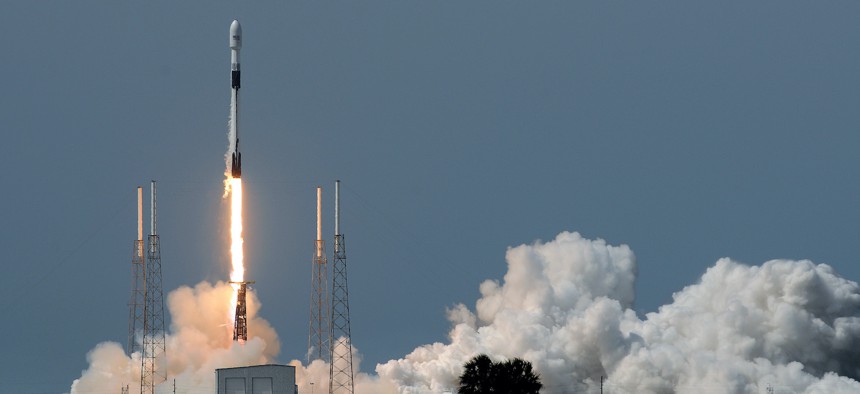
A SpaceX Falcon 9 rocket carrying the GPS III SV03 navigation satellite for the U.S. Space Force launches from Cape Canaveral Air Force Station, Florida, in 2020. Paul Hennessy / SOPA Images / LightRocket via Getty Images
Space Force: We need a hotline to China
Direct communications could ward off miscalculation as space militarizes faster than norms develop, officials say.
AURORA, Colorado—The U.S. Space Force wants a hotline with China to prevent crises in space, as China’s growing number of anti-satellite weapons challenge U.S. dominance in the domain.
“We have to gain consensus among our allies and partners, but it's also important that we have a shared understanding with the potential adversaries so that there is no miscalculation…that's the value of the hotline, because the international norms are not well-established yet, despite U.S. efforts to take a leadership role in that area,” said Brig. Gen. Anthony Mastalir, commander of U.S. Space Forces Indo-Pacific.
Compared to norms in the maritime and air domains, rules of engagement in space remain “somewhat immature,” Mastalir told reporters at the Air & Space Forces Association Warfare Symposium.
“When you think about a hostile act or demonstrating hostile intent in space, what does that look like? And do all nations have a shared understanding of what that looks like?” Mastalir said.
U.S. and Chinese military leaders recently restored communications, after had China broken them in 2022 as a result of then-House Speaker Nancy Pelosi visit to Taiwan. However, a hotline for space operations would be a new channel for Chinese and American officials to speak to each other.
Mastalir’s comments come as officials continue to raise the red flag about China’s growing arsenal of space weapons, and as the Space Force expands its presence in the Pacific.
The service has “everything in place” to stand up a new component in Japan this year, Mastalir said, which would mirror the activation of U.S. Space Forces Korea at the end of 2022.
China’s on-orbit anti-satellite weapons, or ASATs, are a huge concern for the U.S., Mastalir said, and the jamming and directed energy capabilities China is building are also worrisome.
“What I am most concerned about are the capabilities that the joint and combined warfighters in the Indo-Pacific [area of responsibility] depend upon, and many of those are held at risk by directed energy capabilities that China is building—not just to dazzle, but to be destructive,” he said.
China destroyed one of its own satellites in 2007, a move that U.S. Space Force officials have not forgotten.
“While it was in 2007 that they did a direct-ascent ASAT, I'm worried about until we get to a proliferated architecture that we have satellites that are at risk from China from that,” said Lt. Gen. Douglas Schiess, commander of the newly established Space Forces-Space component, which gives combatant commands space support.
“I'm concerned about the amount of jammers that they have. Obviously, the joint warfighters need their communications, they need their data. Think about missile warning, the ability to provide that to the tactical user so that they can duck and cover and that they can be prepared for that. With the amount of jammers they have, we have to have the ability to fight through that,” Schiess said.
The U.S. “can’t allow China” to catch up with the U.S. in space capabilities, Schiess said.




